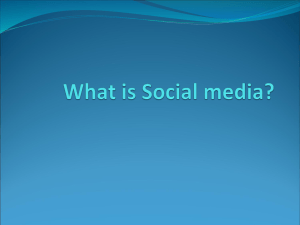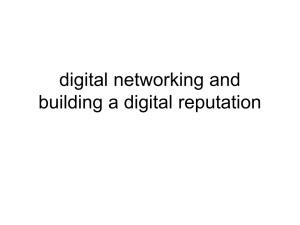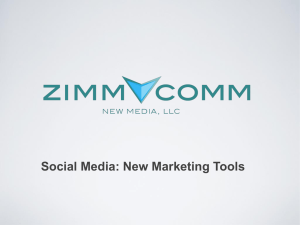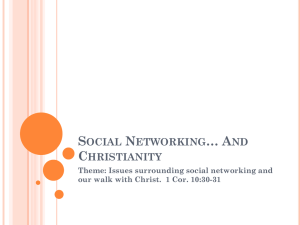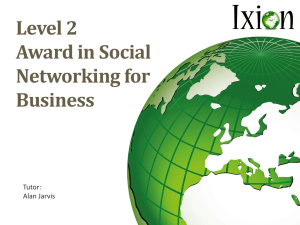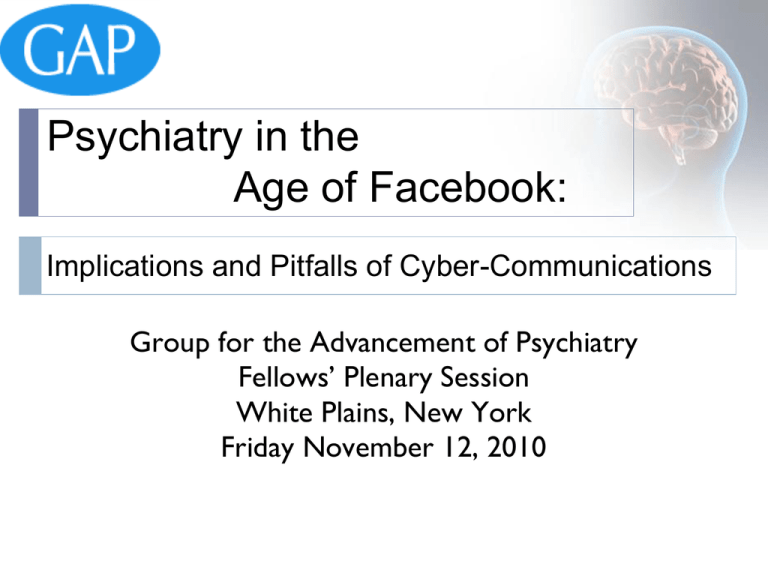
Psychiatry in the
Age of Facebook:
Implications and Pitfalls of Cyber-Communications
Group for the Advancement of Psychiatry
Fellows’ Plenary Session
White Plains, New York
Friday November 12, 2010
Objectives
To introduce the various modes of electronic
communication and online social networking
To discuss implications of social media on
Society
Patients
Psychiatry
To review existing guidelines and present a framework for
more comprehensive guidelines
To present results of our survey of the GAP membership
Psychiatry in the
Age of Facebook:
Survey of the GAP Membership
GAP Survey
To study patterns of electronic communication and social
networking use among GAP members
The survey was designed by reviewing and modifying
available survey instruments
Study approved by IRB, Tufts Medical Center
Survey mailed out to GAP members February 2010
Survey collected at April 2010 GAP meeting
Demographics
178/262 (68%) members responded
Mean Age: 58.3 ± 14
Practice Patterns: 56% academic; 41% private
Effort: 73% FT; 27% P/T
Psychiatry in the
Age of Facebook:
Introduction to Social Media
Social Networking – What is it?
The Ultimate Source of Knowledge
SOUTH PARK
Social Networks
“Blogs” (Weblogs)
Wikis
Content Communities
Microblogging
Facebook
“A social utility that helps people communicate more
efficiently with their friends, family and coworkers” –
Facebook.com
Basic format includes Home Page and Profile, with “News
Feed” of updates of one’s “friends”
Facebook Growth
Facebook Stats
>500 million users
50% log on in a given day
36% of time on the internet
70% of Facebook Users outside the US
Average User:
130 “friends”
80 community pages, groups, events
90 pieces of content each month
> 55 minutes per day on Facebook
Psychiatry in the
Age of Facebook:
Implications for Patients and Society
Possible Societal Benefits of Social
Networking
Increased “social capital”
Bridging Capital
Bonding Capital
Possible Societal Benefits of Social
Networking
Increased “social capital”
Maintenance of social connections
Formation of groups based on similar interests
Practical benefits
Possible increase in productivity
Possible Societal Harms of Social Networking
Decreased quality of interpersonal communication
Prevent the establishment of mature relationships
Ability to propagate harmful/malicious content
Possibly addictive
Prolong the “normal” narcissism of adolescence
Source: Oliver Widder, Geek & Poke blog, Apr. 26, 2008
Texting and risk-taking
Survey of 4000 students at 20 urban high school
20% sent ≥120 texts per day
These were 3.5x more likely to have had sex than others
10% spend ≥ 3 hours per day on social networks
4% do both
These were at 2x the risk for fighting, smoking, binge
drinking, becoming cyber-victims, thinking about suicide,
missing school, and dozing off in class
S Frank, APHA conference, 2010
Survey Results
Do GAP members text with patients?
(0)
0% almost always
(6) 3.4% routinely
(5)
2.8% sometimes
(11)
6% rarely
(150)
84% never
0%
Texting with Patients (N=172)
3%
3%
6%
Almost Always
Routinely
Sometimes
Rarely
Never
88%
Survey Results
What are the contents of GAP members’
texts to patients?
(24) appointments
(2) clinical information
(2) medication management
(5) therapeutic information
(3) respond to patients’ request for clinical info
Megan Meier
Tyler Clementi
Psychiatry in the
Age of Facebook:
Private vs. Professional Identities: The Online Presence
Cyber Identity - Physicians
Medical Students, Residents and Facebook
Online Posting by Medical Students
Professional or Personal Identity?
Survey Results
How Many GAP Members
Post Online?
(4)
(17)
(13)
(46)
(92)
2.3% almost always
10% routinely
7.6% sometimes
27% rarely
53% never
Survey Results
How Many GAP Members
Restrict Online Personal
Information?
(67)
(25)
(9)
(5)
(53)
42% almost always
16% routinely
5.6% sometimes
3% rarely
33% never
Professional…but Inappropriate?
The Medical School Skit
Psychiatry’s Online Presence
Pro-Psychopathology Web Sites
“Pro Ana” and Suicide Forums
The Antipsychiatry Coalition
“Googling” Doctors - What Can One Find?
Training, Board Certification,
Publications
Performance Data
Disciplinary Action, Malpractice Suits
Mortgage Deed, Marital Status,
Political Views
Criminal Background
Slanderous Information
Survey Results
How Many GAP Members
“Google” Themselves?
(4)
(18)
(51)
(78)
(22)
2% almost always
10% routinely
29% sometimes
45% rarely
13% never
“Googling” Patients – What Can One Find?
Clinically Useful Information
Information that Patients May Not Tell You…
Public Records (criminal, tax, marriage, etc.)
Posts to Social Networking Sites
Ethical Problem – Handling the Information?
Survey Results
How Many GAP Members
“Google” Patients?
(2)
(2)
(7)
(48)
(110)
1% almost always
1% routinely
4% sometimes
28% rarely
65% never
And - Info From Social Networking Sites
A New Ethical Issue
The “Friend Request”
Survey Results
Have you experienced positive outcomes from social
networking?
(5)
(32)
(54)
(18)
(40)
3% almost always
21% routinely
36% sometimes
12% rarely
27% never
Positive Outcomes from Social Networking (N=149)
3%
27%
21%
Almost Always
Routinely
Sometimes
Rarely
12%
Never
37%
Survey Results
Have you experienced negative outcomes from social
networking?
(2)
1% almost always
Negative Outcomes from Social Networking (N=159)
(6) 4% routinely
1%
4%
(23)
14% sometimes
14%
Almost Always
(31)
19% rarely
Routinely
Sometimes
(97)
62% never
62%
19%
Rarely
Never
Survey Results
Common negative outcomes from social networking
Miscommunication (6x)
Excessive e-mailing and information from patients/families (4x)
Suicide threats or threatening content (3x)
Facebook Woes – requests and denials (3x)
Psychiatry in the
Age of Facebook:
Guidelines
What’s out there
Email
Social Networking
Patient-targeted googling (PTG)
Texting
Online presence
Ethics
Professionalism/Education
Email Guidelines
Establish turnaround time and types of transactions
Inform patients about privacy issues
Establish types of transactions
Print all messages in chart
Avoid sarcasm, anger, etc.
Get informed consent
Kane and Sands, JAMIA, 1998
Survey Results
How many GAP members email patients?
(4) 2.2% almost always
(8) 4.5% routinely
(43) 24% sometimes
(62) 35% rarely
(55) 31% never
Emailing Patients (N=172)
2% 5%
32%
25%
Almost Alw ays
Routinely
Sometimes
Rarely
Never
36%
Survey Results
What are the contents of GAP members’
emails to patients?
(90) appointments
(24) clinical information
(27) medication management
(26) therapeutic interventions
(36) respond to patients’ request for clinical information
Survey Results
Do GAP members get authorization to email patients?
(51)
(57)
(8)
44% never request permission
50% get verbal permission
7% get written permission
Social Networking Guidelines
Avoid dual relationships by not immediately accepting an
invitation to become an online friend with a patient.
Respect patients' privacy by carefully managing any
information garnered about them on social networking
sites or from other online information sources.
Exercise restraint when disclosing personal information
on social networking sites or other sites on the internet.
Read and understand the site's privacy settings in order
to maintain control over who can acess one's online
profile.
Guseh, Brendel, and Brendel, J Med Ethics, 2009
Patient-targeted Googling
Why do I want to conduct this search?
Would my search advance or compromise the treatment?
Should I obtain consent to do so?
Should I share the results of the search with the patient?
Should I document the findings in the medical record?
How do I monitor my motivations and the ongoing riskbenefit profile of searching?
Clinton, Silverman, and Brendel, Harv Rev Psychiatry, 2010
What’s missing
Texting, online presence
Comprehensive guidelines covering the various modes of
electronic communication
Discipline-specific, endorsed guidelines
Why there are few guidelines
New technologies are emerging quickly
Few legal precedents
Generation GAP
What’s needed in a guideline
A comprehensive set of guidelines covering issues of
treatment frame, patient privacy, medico-legal
issues, and professional issues, across multiple
domains of electronic communications that addresses
discipline-specific issues and is accepted by the
professional community as the standard of care.
Email
Social
networking
Texting
Treatment
frame
Patient
privacy
Medicolegal
issues
Professional
issues
Online
presence
Email
Texting
Treatment
frame
Establish acceptable means of communication
Establish expected turn-around time
Avoid friending a patient
Discuss friending requests with patients
Consider how to respond to requests to view online
information about a patient
Are your decisions going to advance or hinder treatment
Social
networking
Online
presence
Email
Texting
Patient
privacy
What information gathered online enters a patient’s
chart?
Security of electronic communication (with patients,
other clinicians)
Security of electronic devices (phone, computer, etc.)
Social
networking
Online
presence
Email
Texting
Understand your institutions guidelines/policies
Create your own guidelines
Obtain written informed consent from patients about
expectations for communication, turn-around time,
potential risks and benefits of electronic communication
Medico-legal
issues
Social
networking
Online
presence
Email
Texting
What is out there about you?
Think twice about posting material online about yourself
Understand the privacy settings of the online sites you
use
Professional
issues
Social
networking
Online
presence
The following will be added to the GAP website
This presentation
Annotated bibliography
Link to AADPRT bibliography
Fellows 2009-2010
Neil Aggarwal
Benjamin Brody
Gwyn Cattell
David Cochran
Mandy Garber
Stephanie Giannandrea
Hesham Hamoda
Rose Julius
Steve Koh
Aaron Krasner
Fred Langheim
Chad Lemaire
Rebecca Lewis
David Sasso
Megan Testa
Terrorism and Political Violence
Mental Health Services
Family
Child Psychiatry
Cultural
Psychotherapy
IMG
Psychiatry and the Community
Aging
Adolescence
Preventive Psychiatry
Disasters and Terrorism
Psychopathology
College Student
Psychiatry and the Law


